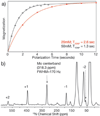Resolution and polarization distribution in cryogenic DNP/MAS experiments
- PMID: 20454732
- PMCID: PMC4085575
- DOI: 10.1039/c003763j
Resolution and polarization distribution in cryogenic DNP/MAS experiments
Abstract
This contribution addresses four potential misconceptions associated with high-resolution dynamic nuclear polarization/magic angle spinning (DNP/MAS) experiments. First, spectral resolution is not generally compromised at the cryogenic temperatures at which DNP experiments are performed. As we demonstrate at a modest field of 9 T (380 MHz (1)H), 1 ppm linewidths are observed in DNP/MAS spectra of a membrane protein in its native lipid bilayer, and <0.4 ppm linewidths are reported in a crystalline peptide at 85 K. Second, we address the concerns about paramagnetic broadening in DNP/MAS spectra of proteins by demonstrating that the exogenous radical polarizing agents utilized for DNP are distributed in the sample in such a manner as to avoid paramagnetic broadening and thus maintain full spectral resolution. Third, the enhanced polarization is not localized around the polarizing agent, but rather is effectively and uniformly dispersed throughout the sample, even in the case of membrane proteins. Fourth, the distribution of polarization from the electron spins mediated via spin diffusion between (1)H-(1)H strongly dipolar coupled spins is so rapid that shorter magnetization recovery periods between signal averaging transients can be utilized in DNP/MAS experiments than in typical experiments performed at ambient temperature.
Figures





Similar articles
-
DNP NMR of biomolecular assemblies.J Struct Biol. 2019 Apr 1;206(1):90-98. doi: 10.1016/j.jsb.2018.09.011. Epub 2018 Sep 29. J Struct Biol. 2019. PMID: 30273657 Review.
-
Polarizing agents and mechanisms for high-field dynamic nuclear polarization of frozen dielectric solids.Solid State Nucl Magn Reson. 2011 Sep;40(2):31-41. doi: 10.1016/j.ssnmr.2011.08.001. Epub 2011 Aug 6. Solid State Nucl Magn Reson. 2011. PMID: 21855299 Free PMC article. Review.
-
Efficient DNP NMR of membrane proteins: sample preparation protocols, sensitivity, and radical location.J Biomol NMR. 2016 Mar;64(3):223-37. doi: 10.1007/s10858-016-0023-3. Epub 2016 Feb 12. J Biomol NMR. 2016. PMID: 26873390 Free PMC article.
-
Dynamic Nuclear Polarization-Enhanced Biomolecular NMR Spectroscopy at High Magnetic Field with Fast Magic-Angle Spinning.Angew Chem Int Ed Engl. 2018 Jun 18;57(25):7458-7462. doi: 10.1002/anie.201801016. Epub 2018 Apr 27. Angew Chem Int Ed Engl. 2018. PMID: 29566299
-
Cryoprotection of lipid membranes for high-resolution solid-state NMR studies of membrane peptides and proteins at low temperature.J Biomol NMR. 2014 Aug;59(4):263-77. doi: 10.1007/s10858-014-9845-z. J Biomol NMR. 2014. PMID: 25015530 Free PMC article.
Cited by
-
A high-field cellular DNP-supported solid-state NMR approach to study proteins with sub-cellular specificity.Chem Sci. 2023 Sep 5;14(36):9892-9899. doi: 10.1039/d3sc02117c. eCollection 2023 Sep 20. Chem Sci. 2023. PMID: 37736634 Free PMC article.
-
A biradical-tagged phospholipid as a polarizing agent for solid-state MAS Dynamic Nuclear Polarization NMR of membrane proteins.Solid State Nucl Magn Reson. 2019 Aug;100:92-101. doi: 10.1016/j.ssnmr.2019.04.003. Epub 2019 Apr 17. Solid State Nucl Magn Reson. 2019. PMID: 31029957 Free PMC article.
-
A 250 GHz gyrotron with a 3 GHz tuning bandwidth for dynamic nuclear polarization.J Magn Reson. 2012 Aug;221:147-53. doi: 10.1016/j.jmr.2012.03.014. Epub 2012 Mar 29. J Magn Reson. 2012. PMID: 22743211 Free PMC article.
-
Spectroscopy: Clear signals from surfaces.Nature. 2010 Nov 18;468(7322):381-2. doi: 10.1038/468381a. Nature. 2010. PMID: 21085166 No abstract available.
-
Primary Transfer Step in the Light-Driven Ion Pump Bacteriorhodopsin: An Irreversible U-Turn Revealed by Dynamic Nuclear Polarization-Enhanced Magic Angle Spinning NMR.J Am Chem Soc. 2018 Mar 21;140(11):4085-4091. doi: 10.1021/jacs.8b00022. Epub 2018 Mar 12. J Am Chem Soc. 2018. PMID: 29489362 Free PMC article.
References
-
- Carver TR, Slichter CP. Phys. Rev. 1956;102:975–980.
-
- Rosay M, Lansing JC, Haddad KC, Bachovchin WW, Herzfeld J, Temkin RJ, Griffin RG. J. Am. Chem. Soc. 2003;125:13626–13627. - PubMed
Publication types
MeSH terms
Substances
Grants and funding
LinkOut - more resources
Full Text Sources
Other Literature Sources
Research Materials

